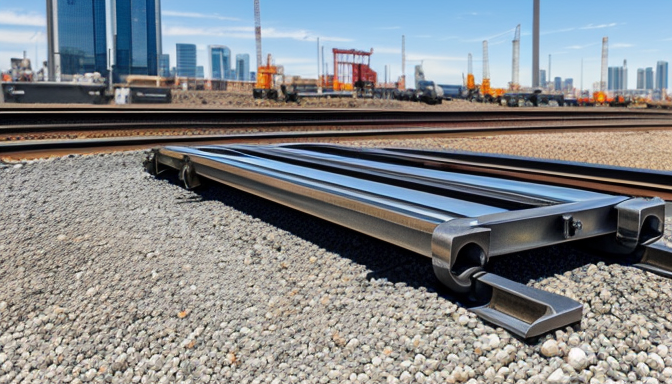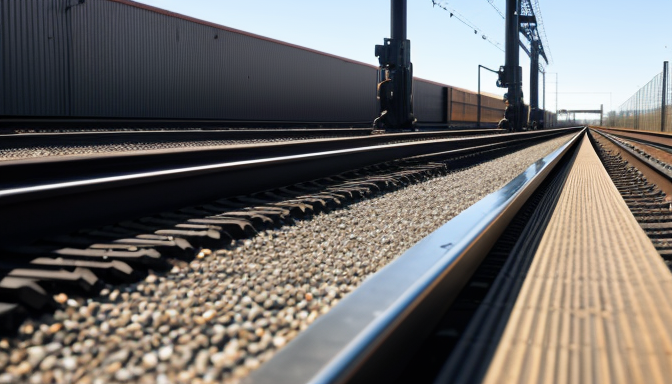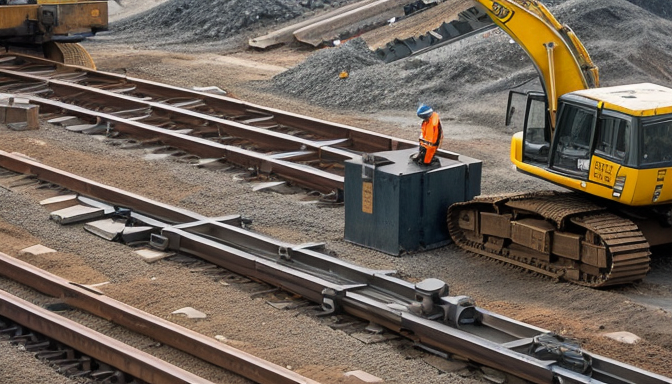Steel rails are more than just long metal bars; they are the backbone of our transportation infrastructure. Imagine a world without trains—it’s hard, right? Steel rails are critical for moving people and goods efficiently across vast distances. They provide the strength and durability necessary to support heavy loads and withstand the elements. In this article, we will explore the many facets of steel rails, including their pricing, weight, properties, sizes, and applications in various industries. Whether you’re a student, a professional in the construction field, or just curious about how these steel giants work, you’re in the right place!
Understanding the factors that influence the pricing of steel rails is essential for budgeting and procurement. The cost of steel rails can fluctuate based on several factors. Market trends play a significant role, especially with changes in demand and supply. When more people want to build railroads, prices can go up. On the flip side, if there’s a surplus, prices might drop. Additionally, the cost of raw materials, like iron ore and coal, directly impacts the price of steel. Labor costs and transportation also factor in. So, when you’re looking to buy steel rails, keep an eye on these elements. It can save you a lot of money!
The weight of steel rails is a crucial aspect to consider. Heavier rails can carry more weight, which is essential for high-speed trains or heavy freight. For example, standard rail weights can range from 40 to 150 pounds per yard. This variation affects how they perform under pressure. A lighter rail might be easier to install but could wear out faster, while a heavier rail provides more stability but requires more effort to move. Understanding these weights can help in choosing the right rail for your project.
Steel rails possess unique properties that contribute to their durability and strength. Let’s break it down:
- Tensile Strength: This refers to how much force a rail can withstand before breaking. Higher tensile strength means better performance under heavy loads.
- Hardness: Harder rails resist wear and tear, making them last longer in high-traffic areas.
- Resistance to Wear and Fatigue: Over time, rails face constant pressure and movement. Properties that enhance resistance to these factors are crucial for longevity.
These characteristics ensure that steel rails can handle the demands of daily use, making them a reliable choice for railways worldwide.
Steel rails come in various sizes tailored for different applications. The most common sizes are based on the standard dimensions set by rail authorities. Typically, the length of rails can vary from 39 to 80 feet, and their profiles differ based on the intended use. For instance, lighter rails might be used in urban transit systems, while heavier ones are reserved for freight and high-speed trains. Understanding these sizes is vital for ensuring that the right rail is used in the right place. It’s like choosing the right tool for a job—using the wrong size can lead to problems down the line.
Steel Rail Price
Understanding the factors that influence the pricing of steel rails is essential for anyone involved in budgeting and procurement. It’s not just about picking a number; it’s about grasping the market trends, material costs, and other economic factors that can affect prices. For instance, did you know that the price of steel can fluctuate due to global demand? When construction booms, the prices often rise. Conversely, during economic downturns, prices may drop.
Another factor to consider is the quality of steel. Different grades of steel have varying costs. Higher quality steel, which offers better durability and strength, typically comes at a premium. Thus, if you’re looking for long-lasting rails, you might have to dig a little deeper into your budget. It’s a classic case of “you get what you pay for.”
Here’s a quick breakdown of some key elements that can impact steel rail prices:
- Raw Material Costs: The price of iron ore and scrap steel can significantly influence overall costs.
- Manufacturing Processes: Advanced manufacturing techniques can increase production costs but result in higher quality products.
- Market Demand: If demand spikes due to new railway projects, expect prices to follow suit.
- Transportation Costs: The distance from the manufacturing plant to the installation site can add to the final price.
For a clearer picture, let’s look at a sample price range for different types of steel rails:
| Type of Steel Rail | Price per Ton |
|---|---|
| Standard Rails | $600 – $800 |
| Heavy Rails | $800 – $1,000 |
| Light Rails | $500 – $700 |
As you can see, prices can vary quite a bit. This variance can be attributed to the factors we discussed earlier. So, before making a purchase, it’s wise to do your research. Speak with suppliers, compare quotes, and don’t hesitate to negotiate. After all, securing the best price can make a significant difference in your project’s bottom line.
In conclusion, knowing the ins and outs of steel rail pricing can empower you in your decision-making process. It’s not just about the cost; it’s about understanding the value you’re getting for your investment. So, stay informed and make choices that align with your project needs.

Steel Rail Weight
The weight of steel rails is more than just a number on a scale; it’s a fundamental factor that influences everything from transportation logistics to installation methods. Think about it: when you’re dealing with heavy machinery and extensive rail networks, every pound counts. The weight directly impacts the structural integrity of the rail systems and their overall performance. For instance, heavier rails tend to provide better stability and durability, especially in high-traffic areas.
Typically, steel rails are categorized by their weight per unit length, often measured in pounds per yard (lbs/yd) or kilograms per meter (kg/m). Understanding these weights can help in planning and budgeting for projects. Here’s a quick overview of some common rail types and their average weights:
| Rail Type | Weight (lbs/yd) | Weight (kg/m) |
|---|---|---|
| Light Rail | 50 | 22.5 |
| Standard Rail | 100 | 45.0 |
| Heavy Rail | 130 | 58.6 |
As you can see, the weight varies significantly based on the type of rail. Light rails, suitable for trams and less demanding applications, weigh much less than heavy rails, which are designed for freight and high-speed trains. This difference is critical when considering the load-bearing capacity and the overall safety of the rail system.
Moreover, the weight of the rail affects the installation process. Heavier rails require more robust equipment for handling and laying them down. This can lead to increased costs and longer installation times. On the flip side, lighter rails might be easier to install, but they may not withstand the same pressures as their heavier counterparts.
In conclusion, the weight of steel rails is a key aspect that cannot be overlooked. It influences not only the performance and durability of the rail but also the logistics of installation and transportation. When planning a rail project, always consider how the weight of the rails will affect every stage of the process.
Steel Rail Properties
When it comes to steel rails, understanding their properties is key to appreciating their role in various industries. These properties not only determine how well they perform but also how long they last. Think of steel rails as the backbone of transportation systems. They need to be strong, reliable, and capable of withstanding heavy loads and harsh conditions.
One of the most important properties of steel rails is tensile strength. This refers to the maximum amount of tensile (pulling) stress that a material can withstand before breaking. High tensile strength is crucial for rails, as they often bear the weight of heavy trains. Without this strength, rails could warp or even snap under pressure, leading to dangerous situations.
Another critical property is hardness. Hardness measures a material’s resistance to deformation. For steel rails, this means they can resist wear and tear from constant friction with train wheels. Imagine trying to run a marathon in shoes that wear out after a few miles. You wouldn’t get very far! Similarly, if rails aren’t hard enough, they would degrade quickly, leading to costly repairs and downtime.
Additionally, resistance to wear and fatigue is vital for the longevity of steel rails. Over time, repeated stress can cause materials to develop tiny cracks, which can grow larger and lead to failure. Good quality steel rails are designed to minimize this risk. They can handle the daily grind of heavy trains without succumbing to fatigue. This property is particularly important in busy rail networks where trains run frequently.
Moreover, the chemical composition of steel also plays a significant role in its properties. Elements like carbon, manganese, and chromium can enhance strength and durability. For instance, adding carbon makes steel tougher, while manganese can improve its hardness. It’s like cooking; the right ingredients make all the difference in the outcome.
To summarize, here are some key properties of steel rails:
- Tensile Strength: Essential for bearing heavy loads.
- Hardness: Resists wear from constant friction.
- Resistance to Wear and Fatigue: Ensures longevity and safety.
- Chemical Composition: Affects overall performance and durability.
In conclusion, the properties of steel rails are not just technical specifications; they are the very reasons why these rails are trusted worldwide. Their ability to endure harsh conditions, support heavy loads, and provide safety makes them indispensable in the transportation industry. So, the next time you see a train rolling down the tracks, remember the strength and durability of the steel rails that make it all possible.

Steel Rail Sizes
When it comes to steel rails, size matters. Just like how a well-fitted shoe can make all the difference in comfort, the right rail size is crucial for ensuring safety and efficiency in transportation. Steel rails come in various sizes, each tailored for specific applications. Understanding these sizes can help you make informed decisions, whether you’re in construction, transportation, or any industry that relies on rail systems.
Typically, steel rails are categorized by their weight per meter. This weight can significantly influence their performance and the load they can carry. For instance, lighter rails may be suitable for light rail systems, while heavier rails are often used in freight and high-speed train applications. Here’s a quick rundown of some common rail sizes:
| Rail Type | Weight (kg/m) | Typical Application |
|---|---|---|
| Light Rail | 20-30 | Urban transit systems |
| Standard Rail | 30-50 | Passenger trains |
| Heavy Rail | 50-70 | Freight trains |
As you can see from the table, the weight of the rail often correlates with its intended use. A light rail, for example, is designed for urban transit and is typically less demanding than a heavy rail, which must withstand the rigors of freight transportation. But size isn’t just about weight; it also involves the profile of the rail. The profile refers to the shape and dimensions of the rail, which can affect its strength and compatibility with existing rail systems.
In addition to weight and profile, the length of the rail is another essential factor. Standard lengths can vary, but they often range from 12 to 30 meters. Longer rails can reduce the number of joints needed, which in turn enhances the stability and smoothness of the ride. Think of it like a long, uninterrupted stretch of road; it’s much smoother than a bumpy, patchy one.
Ultimately, the right steel rail size can lead to better performance and longevity. Choosing the appropriate size isn’t just a technical decision; it’s about ensuring safety and efficiency for everyone who relies on these vital components. So, whether you’re laying down new tracks or upgrading existing ones, remember: the right size can make all the difference!
Frequently Asked Questions
- What factors influence the price of steel rails?
The price of steel rails can be affected by various factors, including the cost of raw materials, market demand, and economic conditions. For instance, fluctuations in the price of iron ore and scrap metal can lead to changes in steel rail pricing. Additionally, transportation costs and supplier competition also play significant roles.
- How much do steel rails typically weigh?
The weight of steel rails varies depending on their type and size. Generally, standard rails can weigh anywhere from 40 to 140 pounds per yard. Heavier rails are often used for high-speed trains and heavy freight, while lighter rails may be suitable for lighter applications.
- What are the key properties of steel rails?
Steel rails are known for their impressive tensile strength, which allows them to withstand heavy loads and stress. They also exhibit high hardness levels, providing resistance to wear and fatigue. Other important properties include their ability to resist deformation and their durability in various environmental conditions.
- What sizes do steel rails come in?
Steel rails are available in a range of sizes tailored to specific applications. Common dimensions include lengths of 39 to 80 feet and profiles that vary based on the rail type. The size of the rail impacts its use in railway systems, where different gauges and lengths are needed for various operational requirements.
- What industries use steel rails?
Steel rails are primarily used in the railway industry for train tracks, but they also find applications in construction, mining, and even amusement parks. Their strength and durability make them suitable for any situation where heavy loads need to be supported over long distances.
